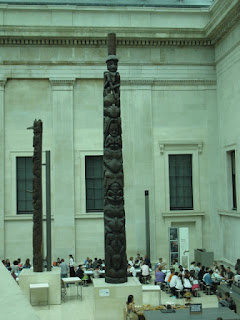 |
| At the British Museum |
After leaving the British Museum I walked to Russell Square where I had lunch at the cafe in the gardens and then went off to The Foundling Museum which is not that far away. The house, which looked after babies and children whose mothers were destitute, had very famous sponsors from the art world, many donated paintings - William Hogarth, Joshua Reynolds and Thomas Gainsborough among them. The composer Handel also helped to raise funds and in a room at the top of the building is a collection of some of his works (as well as programmes, scores and books)and his harpsichord. There is a wonderful round table with a timeline on it, putting Handel in contexts with other historical happenings. For me one of the exciting things was discovering the five red wing backed chairs. No ordinary chairs, but musical chairs! The wings have speakers in them and you can choose what you want to listen to. Each chair holds four pieces of Handel's music - ranging from operetta, orchestral, sacred etc. I enjoyed listening to one of my favourite Handel pieces 'Zadok The Priest', and some of the 'Firework Music'.
The other rooms consist of paintings which were donated and some painted by Emma Brownlow who I believe was the daughter of the founder, Thomas Coram's. Her paintings are lovely. Other paintings are by the sponsors mentioned above. One room has a wonderful Rococo ceiling which is beautiful to see. The main exhibition is on the ground floor where you can see the heartbreaking tokens left by mothers to identify their children. Sometimes mothers came back when their circumstances changed and found that their child had died. Babies were sent away to be looked after and came back to London when they were older. The children were given an education. The regime was rigid but they had a chance to make something of their life. Also when mothers left their children, they were given new names because it was a new start. It seems harsh but left in poverty the children may well have perished. They left the Foundling when they were fourteen - girls to domestic service, boys to be apprentices. It is a very sobering exhibition and makes you realise how desperate mothers must have been to give up their children. Some children of course were born out of wedlock, some had father's who had walked out and there was no money, others were there because their father's had died.
The work started by Thomas Coram still goes on today. Do have a look at the website.
 |
| The book shop window - The British Museum (outside) |
 |
| Inside the book shop! |
 |
| I'll just take that white book poking out! |
Yesterday in my post I promised a book review for FORENSICS - AN ANATOMY OF CRIME by Val McDermid. It can be found on my other blog up and ready to read!


Comments
Post a Comment